Tagged: seo
Our 4 SEO Insights to Optimize Your Content Strategy in 2025
- by Luke Thiessen
The world of SEO is complex and always changing, but if you want new people to find your content in 2025, you can’t afford to ignore it.
Whether you are writing blogs, product descriptions for an online store or any other web content, your content doesn't mean much if nobody finds it, so it’s important to consider how search engines – and now AI search tools – might find you. As you develop your next round of content, or get ready to revise your entire strategy, make sure to plan with SEO in mind.
Here are our top four SEO insights for optimizing content strategy in 2025.
1. Define your keywords and content pillars
This is SEO 101, but it’s still the place to start, and something to revisit regularly. Make sure your keywords are relevant and will drive the kind of traffic you want to your pages, and focus on a handful of “content pillars” or topics that support your overall goals and provide structure for all of your content.
It is generally helpful to start with one primary keyword for your website, and then branch out into secondary and related keywords (we’ll get into that in the next section). If you are just starting out or wanting to revamp your SEO efforts, the keyword tool from Semrush can be helpful in identifying the keywords you’re already using, and providing some insights.
For content pillars, First Page Sage recommends choosing four to six topics and focusing your keyword research around those as a manageable yet thorough approach.
And of course, once you’ve defined all that, make sure you actually use them!
2. Find related topics and keywords
While far from a new idea in SEO, including synonyms, related keywords and “long-tail variations” (highly specific, multi-word terms) in your copy is becoming increasingly important. Major search engines have come a long way in how they process searches and “interpret” the words and phrases users input, having gotten a lot better at natural language processing and “understanding” the context of a search.
Search engines have been growing in this direction for a while, but with AI tools taking over an increasing share of internet search, this strategy has become even more important. Research data shows that the sheer number of words users enter in an average search query using AI tools is multiple times higher than on conventional search engines, and the complexity of what they are asking is often higher as well.
This means that using a broader range of unique words related to your topic should help your content be found, indexed and ranked higher for relevant queries on both types of search platform. AI tools are looking for both breadth and depth on a subject.
So, make sure to identify your keywords as usual, but also make an exhaustive list of synonyms and possible alternate words and phrases to ensure your content reads as thorough and matches as many (relevant) searches as possible. Adding mention of topics related to your content, even if you don’t discuss them in depth, can also help make your content more attractive to AI search tools.
3. Keep it fresh
Search engines tend to prioritize fresh content, but this doesn’t necessarily have to mean new content all the time.
If you have the capacity to publish high-quality, original content several times per week – and sustain that pace long-term – Google will certainly reward you for it. Research shows that, everything else being equal, regular publishing that it views as high-quality will increase your domain authority and, by extension, search ranking and website traffic.
However, that’s a high bar for most businesses to reach and sustain.
Another way to optimize for “freshness” in your SEO is simply by updating your existing content. Do this periodically, add a fresh timestamp, and search engines will be more likely to keep sending people your way. Certain types of content work better for this than others, something we call “evergreen” content – check out our very own evergreen post on this long-lasting content for tips on how to create and maintain these kinds of pieces.
4. Optimize for AI search while you’re at it
As we’ve already mentioned, some SEO strategies overlap substantially with optimization for AI search due to the changing nature of search engines. But there are some aspects unique to AI search that require additional work if you want users to find you with these tools.
SEO consultant Aleyda Solis offers a thorough list of recommendations for AI search optimization in a recent post, including optimization for “chunk-level retrieval” and “citation-worthiness.”
Chunk-level retrieval means sticking to one idea per section, paragraph or “chunk,” and keeping those passages concise and easily understandable on their own, without users needing to read preceding sections.
Citation-worthiness, at least in this case, means using specific, fact-based claims, and listing citations, credentials and timestamps where relevant.
If possible and relevant to your industry, Solis also suggests optimizing for “content authoritativeness signals,” which is effectively a combination of managing your online presence well (consistent branding, working links, responding to reviews, etc) and publishing and promoting true original content. Consider conducting studies or surveys within your industry and publishing the results. Once you’ve done that, try to get coverage from media and other websites and blogs to reinforce that leadership and authority.
Ultimately, these things are helpful for regular SEO too, but AI search disproportionately rewards content that prioritizes this stuff, because it makes it easy for them to lift and present as an “answer” to a question. And with more and more search being done on AI tools, the effort involved is more and more likely to pay off.
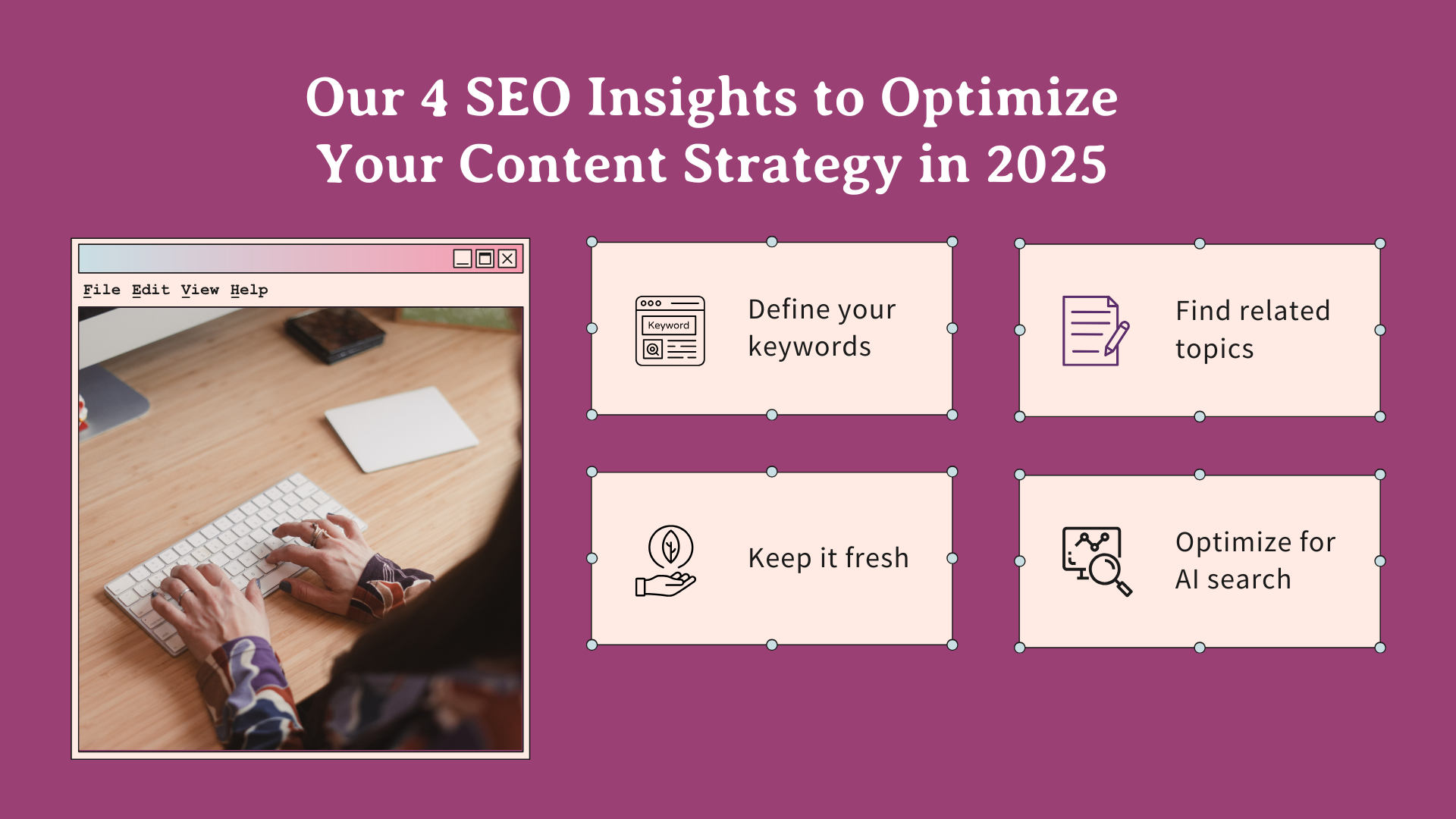
Need help with your SEO?
If you’ve already got a good grasp of SEO principles, the above tips should help you continue to find success as the industry changes around us. But if you don’t know where to start, or would like to see how working with a boutique agency like ours could help elevate your SEO and digital marketing, get in touch! We would be happy to work with you and transform your online presence into something custom-made for your industry in 2025.
What's an Entity First SEO Strategy and How to Build One?
- by Alyson Shane
“Entity search” “might just be one of the most important SEO tactics you’ve never heard of!
This (somewhat) obscure term has become something we’ve been focusing on here at Starling Social since Google updated its topics application program interface (API) back in June of this year.
This update to Google’s most comprehensive and powerful deep learning algorithms means that marketers and businesses need to be thinking more deeply about semantic search than ever before.
If you’re new to terms like “semantic search” and “entity SEO” don’t worry! Today we’re going to dig into what these two terms mean, and how you can leverage them to help customers find your business.
What’s Semantic Search?
Semantic search describes a search engine’s efforts to generate the most accurate results on the search engine results page (SERP) by using algorithms to understand search intent, query context, and the relationship between the words being used.
Or to put it another way: semantic search is a search engine’s attempts to understand natural language the way a person would.
What is Entity Search?
Back in the day, a search was performed almost exclusively by typing words (keywords) into a search engine, but now 40 - 50% of all searches are conversational, meaning that they’re done through smartphones, Alexa, Google Home, etc.
This change is why search engines have put so much energy into understanding the context and intent behind a search query. As a result, search has evolved from keywords, to “entities”.
“Entities” are expressions that a search engine can understand without ambiguity, regardless of the language being used. This can include:
- A person’s name
- A numerical expression
- A place
- An object
- An event
- A concept
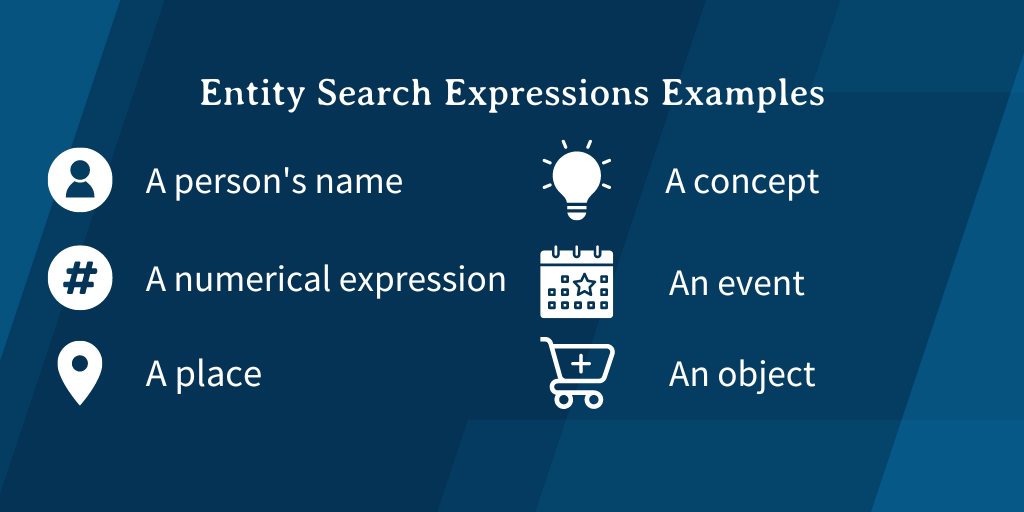
Let’s look at an example: the search query “what’s the cheapest price for an AirBnB in Toronto?”
Here’s how a search engine would understand the query:
- What: A concept (question qualifier)
- Cheapest: A numerical expression (lowest cost)
- Price: Numerical expression
- AirBnB: Organization
- Toronto: Location
By connecting these entities, search engines can understand both the search query, as well as the intent behind it.
Once these areas are understood, a search engine will try to find the most relevant information about the “entities” in the query by scanning content on the web and using AI to sort and present it to the user. This is called “entity/semantic search”.
The Difference Between Entity SEO and Traditional SEO
In traditional SEO, web pages are ranked on “scores” based on relevance, authority, and the number of backlinks from other websites.
Entity SEO focuses on showing the most useful information based on entities, facts associated with those entities and questions related to them.
What
The topic of the search query and what a user expects to find when they search for that topic. This sounds similar to traditional SEO and keywords, but semantic search takes a different approach.
Let’s think back to the example above: how many ways could someone ask the same question? Would it be asked differently in other languages?
Making sure your content is as comprehensive as possible and offers credible information about the topic, and covering as many related topics as possible, is how you can optimize your content for entity SEO.
Why
This describes the intent behind the search. What is the person looking to find out?
Are they considering and comparing options?
Are they looking for directions?
To make a decision?
To complete a transaction?
Using a combination of “what” and “why” will allow you to create content that’s SEO friendly and caters to your customers at every stage of their buying journey, so creating content around these topics and interconnecting them can help your page show up on a SERP more often.
How
Nowadays, how a search was performed is almost as important as what’s being searched for, so consider how your audience might want to consume the information they’re hoping to find.
Video, images, bulleted lists, hours of operation, FAQs and question and answer sections, and more are all excellent ways to create entity SEO-friendly content for your site.
The Four Outcomes Your Content Should Accomplish
The five outcomes you want to accomplish are:
1. Discoverability. Make sure your content is “discoverable” by search engines and by customers at different stages of their buyer’s journey.
2. Relevancy. Your content needs to meet your searcher’s needs and have as much info as possible.
3. User-friendly. Your content needs to be easy to read and understand.
4. Engaging. Engaging content encourages readers to take the desired goal (learn something, sign up, fill out a form, etc.)
Creating content that’s relevant, topical, and increases “discoverability” means keeping these elements in mind:
- The content should be personalized. Readers should feel like it was written for them, specifically.
- The content must tell a story. It needs to be engaging and capture readers’ attention.
- The content should be scannable. It needs to include headers, sub-headers, and elements like bulleted lists to make skimming easier.
- It must include images. These both break up the text, make things clearer, and offer more SEO optimization opportunities.
- The content must be mobile-friendly. According to Statista, 55.79% of all web traffic in Q1 2022 came from mobile devices, so make sure your content is readable on smaller screens.
How to Align Your Content With Entity First SEO
Before we talk about how to align your content, let’s take a quick look at how search engine priorities, algorithms, needs, and results have changed over time:
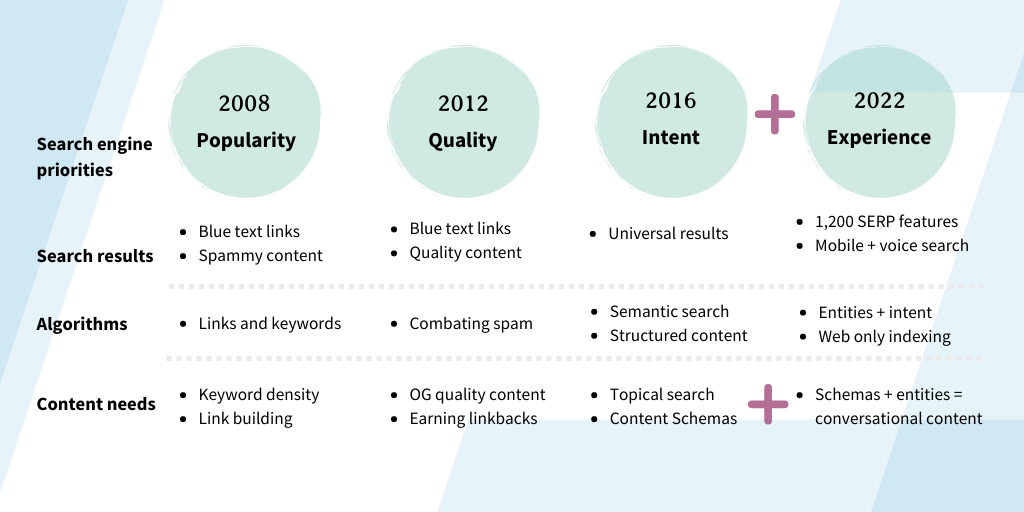
Like we said before: the way people are searching is changing, and the shift to searches performed through “screenless” devices means that the AI powering search engines is trying to replicate how humans think and speak.
If you’re wondering how you can tailor your SEO strategy to match how search engines have evolved, here’s how:
Consider Your Website Schema
This is a bit wonky, so stay with us: schema markup (also known as structured data) is the language of search engines. It was introduced by Google in 2011 as a way of helping search engines display more relevant results to users.
Web schemas are basically words or “shared vocabulary” that help refine searches and display more relevant results to the user.
Here’s an example: you and your friends want to go camping in Red Deer, Alberta… but when you try to perform a search, a bunch of results for red deer the animal come up. This is because Google didn't have context to understand that you wanted information on the city, not the animal.
So when you’re considering the content to write and the metadata to add to various pages on your site, make sure to consider the schema vocabulary to include, and the most relevant pages to include it on.
Consider the Market Opportunity for your Keywords
Use an in-depth keyword research tool (our fav is SEMRush) and do research into how different keywords in your industry are performing.
Then, map your content based on three factors:
1. Informational
2. Navigational
3. Transactional
Here’s an example of what that could look like:
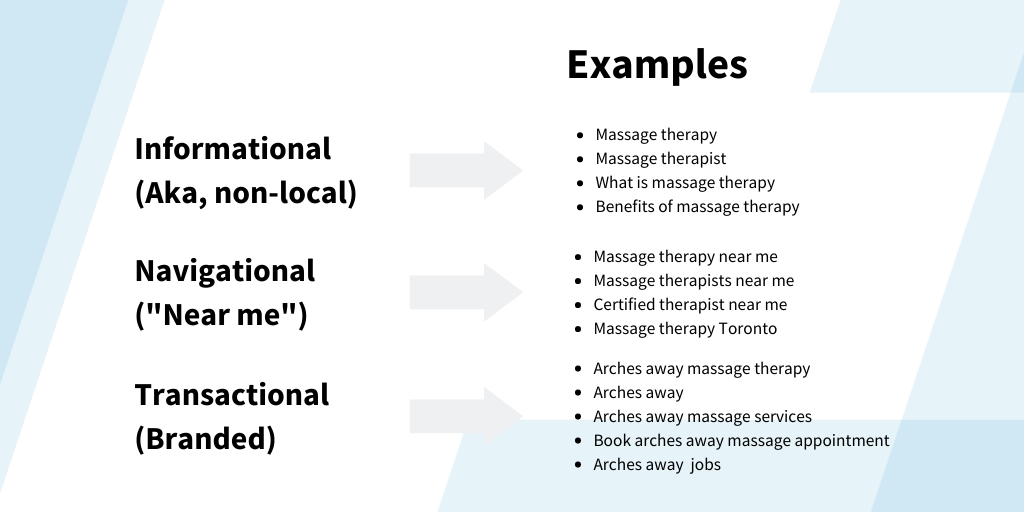
Identify Topic Gaps
Once you’ve identified your high-priority keywords and the best pages to use them on, cross-reference those findings against topics and entities covered by other high-ranking websites.
Some things to cross-reference against your own site include:
- Image alt tags (here’s two easy ways to check)
- Headings
- Lists
- Metadata (here’s how to do that)
Update Your Web Pages
Once you’ve identified what other high-ranking sites are doing, it’s time to compare against the pages on your own site and start identifying the areas where you can start adding in more content and schema-focused keywords.
Some areas you’ll want to focus on updating and optimizing include:
- Meta Keywords Attribute. A series of keywords you deem relevant to the page in question.
- Title Tag. This is the text you’ll see in the SERP and at the top of your browser. Search engines view this text as the “title” of your page.
- Meta Description Attribute. A brief description of the page.
- Meta Robots Attribute. An indication to search engine crawlers (robots or “bots”) as to what they should do with the page.
More info on these topics can be found in this handy article from WordStream.
Protip: if your site is hosted on WordPress, the Yoast SEO tool is a great plugin that can help you optimize all these elements!
Optimize Your SEO for Entity Search: Recap
SEO is more about just the content on your page (though that’s important, too) — you need to consider the page layouts, how they link to one another, design elements, entity coverage, and schema.
To make this easier for yourself, think about the main pages on your site as “spokes” in a wheel, the other relevant pages that link back to it as the “spokes” in that wheel.
To recap, if you want to optimize your site for entity first SEO, take these steps:
- Consider your website schema
- Do research on your target keywords
- Identify topics on other high-ranking sites
- Identify content gaps between those sites and your own
- Update your pages with content, headers, metadata, etc.
Staying up-to-date with the latest SEO trends is easy! Just subscribe to our weekly digital marketing newsletter for the latest articles, resources, and insights.
What is Content Decay? (And How to Fix It)
- by Alyson Shane
No matter what keyword you’re searching for, there’s a pretty good chance that the #1 ranking result on a search engine results page (SERP) won’t be there in a few months.
More than 4.4 million blog posts are published every day, so it’s important to have a content strategy that focuses on your target keywords, includes lots of evergreen content, and a plan to tackle content decay so your posts stay relevant and keep driving high-quality organic traffic to your website.
What’s the difference between direct, organic, and paid traffic?
Direct traffic is traffic that comes directly to your website — usually in the form of someone typing your website URL directly into their address bar.
Organic traffic is traffic that comes to your website from a search engine but wasn’t paid for.
Paid traffic is traffic that arrives on your website as a result of a pay-per-click (PPC) ads campaign that you run on search engines like Google and Bing.
For the purposes of this article, we’ll be focusing on organic traffic and how you can attract more of it.
What is content decay?
Content decay is the term that describes an ongoing decline in organic traffic and rankings on a search engine results page (SERP) for one or more blog posts.
The use of the word “decay” is important here because it describes how the decline happens: it’s not a sudden drop; it’s a gradual decline that can compound over time.
This happens because content that is newer is seen as more relevant by search engines. When someone types a query into Google, one of the details it looks for when showing the most relevant results is how recently the post was published.
To better illustrate this, let’s look at the stages of the content lifecycle:
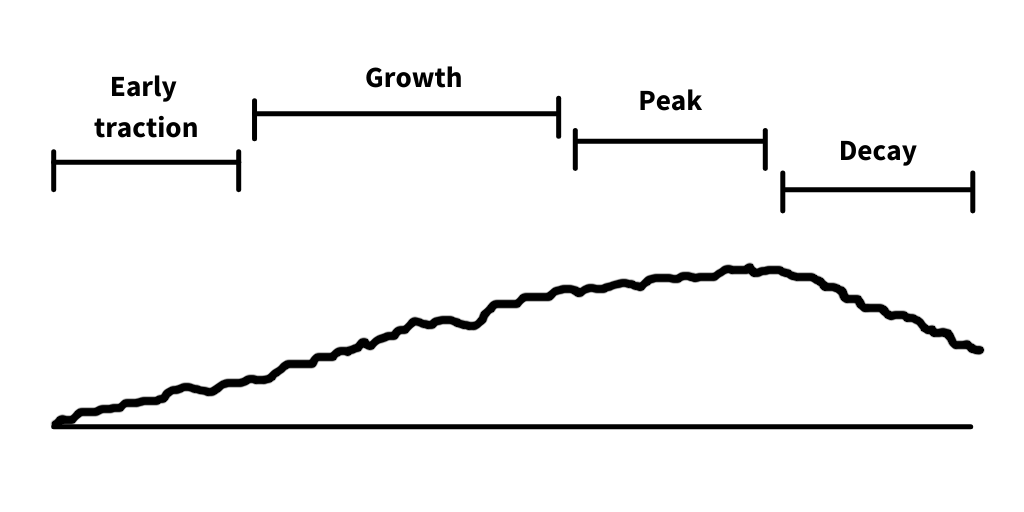
Stage 1: Early traction
A new blog post or page on your website takes time to start ranking on a SERP and drive organic traffic.
This happens because newer content is sorted (or “indexed”) by search engines, which then use algorithms to determine how your blog ranks in terms of being search engine optimized (your SEO), how your content matches search intent, and more.
You might see some spikes in traffic over the first few weeks, especially if you’ve been promoting your blog post in your newsletter and on your social media channels, but generally speaking that will happen at the start and you’ll be back to seeing traffic slowly building over time.
Stage 2: Growth
This phase varies in length, but generally describes the process of your post ranking higher for more queries and gaining backlinks (when another website links to it as a reference).
Like we said: this phase varies in length depending on the post topic, relevancy, and other factors.
Phase 3: Peak
The peak stage is — you guessed it — when growth starts to peak. This can happen for a few reasons:
- The post stopped getting backlinks. People aren’t linking to it as often, which means it’s not staying as competitive on the search engine results page (SERP).
- The post hit a natural ceiling. If the post ranked in the top slot for all the keywords in the topic and is limited by the number of keyword searches per month.
- Someone published a new post (or updated an existing post) about the same topic. “Someone” meaning a competing business publishing content similar to your own.
The length of this stage depends a lot on the factors above.
Stage 4: Decay
This happens when the post starts to age and becomes less relevant (or “fresh”) making it less competitive when being indexed by a search engine. In fact, letting a page go bad can result in a 91.9% loss of both traffic and traffic value.
This can happen even more quickly if the post covers a popular topic that lots of others are writing about.
What causes content decay?
Content decay can happen for a variety of reasons which is why it can be so hard to diagnose and fix, but here are some of the most common reasons:
Freshness, aka content age
Search algorithms prioritize content that was published as recently as possible, so when a blog post is newly published it’s considered “fresh”.
This isn’t to say that content that was published back in 2008 can’t still have some value to the reader, but “freshness” comes down to how well it’s been updated to stay relevant.
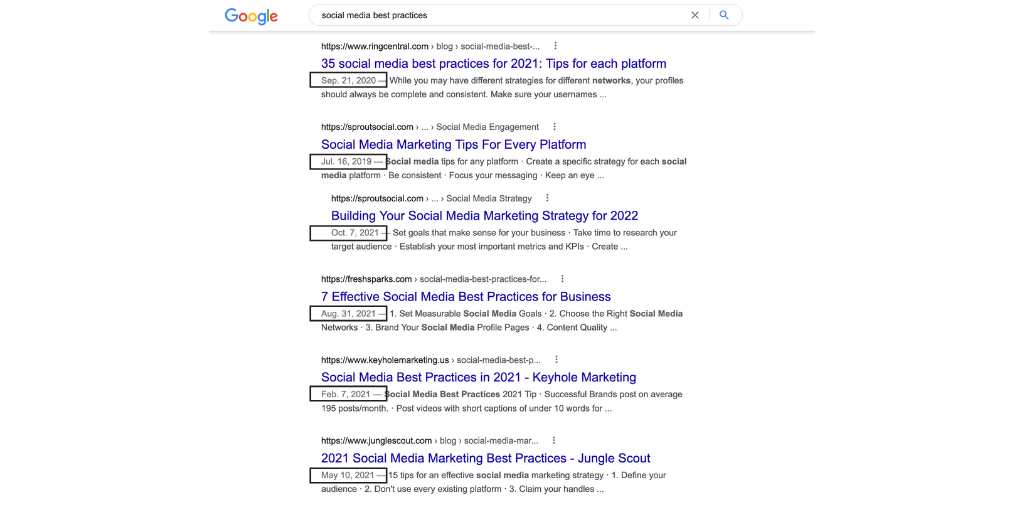
As we can see here, content that’s two years old is a stretch in this SERP.
Search intent shift
“Search intent” refers to what a person is searching for when they type a query into a search engine.
Google and other search engines are always re-evaluating how users interact with the results of a search query to understand their intent. As the way users search for and interact with the results of a query changes, so do the results that rank for that query.
Topical Depth
Just like how search intent can change over time, particular aspects of a topic can evolve as more people continue to search for it.
As a topic evolves, your content might become a less relevant resource, which causes it to decay on the SERP.
Internal competition
This is one of the most common reasons for content decay: you have several pages on your website that all cover roughly the same topic, causing them to compete with each other for rankings.
This makes it harder for search engines to figure out which page to feature and can reduce the performance of all conflicting URLs.
Important: this isn’t just limited to blog posts! Internal competition can refer to competing blog posts, product or service pages, glossary pages, and more.
External competition
This is probably the easiest to understand from a non-technical standpoint: when another website publishes fresher or better-optimized content, which causes yours to decay as a result.
If lots of websites are all competing for rankings and traffic about the same topics then it becomes easy to lose your rankings to them.
There are lots of factors that can cause your content to decay compared to the competition, but some of the most common include:
- Their brand/authority. Bigger companies with brand recognition tend to get more traffic, which search algorithms see as making their content more “valuable”.
- The volume of backlinks. You’ll remember that backlinking is when a website “links back” to our content, so naturally, a website with a lot of brand recognition will get more links back to it from other websites than smaller, lesser-known sites.
- How well they’re aligned with search intent. This means they’ve been optimized for SEO and have elements like the keywords, meta descriptions, and alt tags set up properly.
How does content decay impact organic traffic and SEO?
There are a few ways that content decay impacts where your posts show up on a SERP, including:
Click-through rates (CTRs) drop
2021 research from Zero Limit Web reveals that the first five organic results account for 67.60% of clicks in Google. This means that as your content decays and slips down on the search engine results page (SERP), your click-through rate will decline and cause you to get less traffic over time.
Loss of search visibility
When content starts to decay the number of keywords it ranks for goes down, which means your visibility goes down, too.
Backlinks decrease
Content decay hurts your ability to get backlinks because older content tends to not get linked to as often as “fresher” content.
This is especially true with very old content that hasn’t been updated, since site owners might remove backlinks to your posts if they start to seem irrelevant or out-of-date.
Your site performance goes down
Content decay means that your post isn’t among the best, most relevant results, and that people clicking on your link probably won’t find what they’re looking for.
This can cause people to “bounce” away, which means they’ve left your website without clicking on any additional links like your product or service pages, contact form, etc., and people who don’t stay on your site can’t become customers!
Signs of content decay: what to look for
There are a few ways to identify content decay when looking at a specific URL on your website. They include:
Your click-through rate (CTR) is going down
Click-through rates typically go down when your content starts slipping on the search engine results page (SERP) rankings.
This can be due to a few factors, including:
- A competitor has outranked you
- Search intent has shifted
- Search engines updated the design of the SERPs
Traffic has plateaued
Like we discussed above, traffic plateaus can happen for a variety of reasons.
Sometimes it happens because your page is hitting the natural limit for a topic or keyword — but most of the time a plateau happens because the post is decaying and you’re missing out on potential clicks.
Traffic is declining steadily
Take a look at your traffic over the past six months: if you see a steady decline, that’s a strong sign that your content is decaying.
If the page you’re looking at doesn’t have a high volume of traffic it can be hard to use this as a way to identify decay, so we suggest comparing two date ranges to spot any differences.
Keyword rank and impressions are dropping
People often overlook content that’s decaying because it’s still getting clicks and traffic, but when a post starts losing impressions (number of views) or stops ranking for a wider variety of keywords than it used to, that’s a sign that your content is starting to decay.
Loss of impression share or keyword ranking tell us two things could be happening:
- Search intent is shifting on the topic
- The content on your page isn’t updated to meet this change
How to Grow SEO Traffic by Fixing Content Decay
If you’re starting to feel like content decay is a hopeless game of whack-a-mole — don’t despair! With the right strategy you can update your posts to help them be “fresh” again so they outrank your competition and drive targeted traffic to your website.
Here are a few simple actions you can take to help you fix content decay:
- Expand the word count and add more depth and examples
- Replace outdated statistics and references that make a post look “dated”
- Add internal links from other posts to the updated pages
- Re-promote the updated content in your newsletter and on social media
Looking for a deeper explanation of what to do? We’ve got you covered:
Expand past blog posts
Updating old posts allows you to increase the word count, which helps with SEO since the ideal blog post length should be 2100 - 2400 words.
Adding more content to your old posts makes your posts more valuable to your readers and causes search engines to see the post as “fresh” which helps you rank higher.
An easy way to do this is to perform a content audit that identifies posts that are shorter than they should be.
If you’re not sure what to add, check social media and what people have said when sharing the post to get a sense of what people found valuable about it, then expand on those points.
Important: when updating old posts, always make sure that you keep the same URL so you still get the historical SEO value the post has earned over time.
Add new information to outdated posts
One of the easiest ways to “freshen” up stale content is to update out-of-date or irrelevant information. If your post cites a study that’s more than three years old, update it with something new. If there’s been an industry shift (like a new piece of technology, software update, etc.) make sure to update any outdated or incorrect information.
An easy way to do this is to perform a Google search for the topic and make note of what the sites who are ranking on the first page are talking about.
Ask yourself: “what are they covering that I’m not?” and develop a plan to add those sections to your old post.
Consider new keywords
Don’t forget to reassess your target keywords when updating your content!
Keyword popularity changes all the time, which means that a popular keyword that once sent lots of traffic to your site might not be delivering the same results as it once did. This is especially common with trending keywords, but can happen to any of them.
Tools like SEMrush are great for tracking keyword popularity over time and allow you to track the performance of a specific keyword and look for related keywords that might work better.
You can also use tools like Exploding Topics to track content topics before they become too mainstream and try to capitalize on a wave of interest.
Consolidate old content
This is a great tactic when you have several shorter pieces focusing on the same (or related) topics that aren’t ranking anymore.
If you do this, you have two options:
- Keep one piece as the “main” piece and consolidate the others into it, or
- Create a new post, drawing from the existing content, and consolidating it all together
Important: if you do consolidate your content, make sure to set up the correct 301 redirects from the old URLs to the new one. This shows the search engines that you’ve moved the content and have multiple pages now linking to the main post, and that this is the post you want them to care about and index.
Write new content
Pay attention to moments when you think “this could totally be its own post” when doing your content audit. This thought is a great sign that you can generate more content ideas from the content you’ve already published.
In this situation you may have been ranking and getting impressions for that topic at some point since you mentioned it, but now you’re slipping in the SERPs because other people have been covering it more fully and more recently. As a result, it doesn’t make sense to try and cover the topic in your existing content.
Instead, create new content that takes the decaying part and gives it a new lease on life. This allows you to recapture lost traffic and more by targeting other keywords related to that topic.
Update your internal and backlink strategy
Search engines see content that gets lots of links to it from other sites (backlinking) as more valuable and ranks them higher, so driving links to your newly-updated posts can help give them an SEO boost.
An easy way to do this is to start writing for other sites and including links to your newly-refreshed content. Getting more backlinks from other sites will help your new content perform better than simply updating and re-publishing it.
Make sure not to forget about adding new internal links from other posts to the new and newly-updated posts!
This creates a better user experience for the reader and helps search engines understand the content structure of your website better, both of which help your SEO.
Stop content decay today!
Content decay can feel like a frustrating game of whack-a-mole (and to some extent, it is) but with the right strategy in place you can keep your old content fresh, up-to-date, and keep driving lots of high-quality traffic to your site.
Did you love what you just read? Sign up for our newsletter to get the latest digital marketing news and strategies delivered right to your inbox once a week!
The 5 Most Important Elements of SEO Copywriting
- by Alyson Shane
One of the hardest parts of content marketing is writing copy that’s optimized for search engines, but is still fun and entertaining to read.
Regularly publishing useful, interesting updates (usually to your website's blog) gives people a reason to visit your site over and over again, which familiarizes them with your business, builds trust, and increases the likelihood that they'll buy from you.
In fact, a recent HubSpot survey found that 20% of marketing leaders described company blogs as one of their "most important channels" for hitting goals.
However — this is easier said than done. In order for your blog to be successful, you need to do more than just “write content". Your copy needs to:
- Appeal to your target audience
- Solve a specific problem
- Show how YOU, specifically, solve that problem
The easiest way to convey all of the above is by using strategic SEO keywords to drive targeted traffic to your website.
Keep reading to learn how to write SEO-friendly copy that attracts the right audience to your posts and builds brand awareness with your ideal customers.
What is SEO?
SEO stands for Search Engine Optimization. It refers to the process of writing your website copy and setting up your site in a way that helps it appear on a Search Engine Results Page (SERP).
Where your website shows up (or “ranks”) on a SERP is the result of your SEO.
When it comes to applying SEO to your content strategy, that process looks like this:
- Research keywords relevant to your industry
- Select a particular keyword (or keyword phrase)
- Use that keyword to write a blog post
- Share that post on social media and encourage others to do the same
How Are SERP results calculated?
A search engine’s algorithm calculates SERP results on a few factors, which are:
The content on your page. Things that are measured include the amount of times a keyword (or key phrases) are used throughout your content.
Types of clicks. According to Moz, there are three types of clicks you should pay attention to: First, Long, and Last.
Authority. Authority refers to the number of links pointing back to that page, and how trustworthy those links are. The more popular and linked-to a website is, the more “trustworthy” those websites are.
Think about links like “upvotes” on Reddit: the more upvotes your post gets, the higher it appears at the top of the comment thread. Websites and SERPS work the same way.
The “comment” that gets upvoted is your website, and it receives an “upvote” when a trustworthy website links back to it. Pretty simple, right?
What is SEO copywriting?
SEO is the process of writing content that is useful, ranks well, and communicates expertise and value to your target audience.
The practice of effective SEO copywriting has changed a lot over the years.
Starling Social started as a freelance copywriting business, but back when we started doing SEO copywriting it was more about following a specific format, like mentioning the business name, services, city, and phone number in the opening paragraph of a web page.
Unsurprisingly, this made the internet sound boring and repetitive.
These issues also caused search engines like Google to start rolling out updates to their ranking algorithm and how it parses (categorizes) content on a website.
Nowadays there are lots of factors that go into how a website ranks, but consistently communicating how you solve your customer’s problems through your content is how you write truly “effective” SEO copy.
The 5 most important elements of SEO copywriting
Like we said: there are lots of things that contribute to a web page’s SERP ranking, but when it comes to copy, the most important elements are:
- Headlines
- Content
- Meta descriptions
- Keyword frequency and density
- Page links
1. Headlines
Your headline is one of the most important elements of your SEO copy, since the headline is what catches people’s attention and entices them to click and read further.
Some writers suggest writing your headline first, then writing the rest of your copy, but the order you do it in is up to you. We usually write ours last, and check it against Coschedule’s Headline Analyzer to see how it’ll do.
Not sure how to write snappy headlines? Use these tips as your guide:
- Include a number in the title if possible. Conversion XL found that headlines with numbers earn higher click-through rates.
- Keep your headline short. Search engines cut off titles after 72 characters, so avoid long, meandering headlines if you can help it.*
- Use Google for content inspo. Search for your target keywords and pay attention to the themes that appear in the topic, content, and which headlines turn up — this will show you the hottest topics that are getting the most traffic.
- Use Yoast SEO. This handy WordPress plugin will help you optimize your content for SEO by using an easy-to-understand ranking system.
* For reference, the title of this article “The 5 Most Important Elements of SEO Copywriting” is 48 characters.
2. Content
When someone looks something up, they’re searching for content that meets those needs, and SEO copywriting is how we create the high-quality content that gives them what they’re looking for.
How to strategically plan SEO content
The best way to plan your SEO content is to target keyword phrases, instead of individual keywords. Let’s look at an example:

As we can see, this generic search turns up about 197 million results — not great if you’re a small business without an ad budget to give you an edge in such a crowded space.
Now, let’s take a look at a more specific keyword phrase and compare:

By targeting a more niche keyword phrase, we reduced the volume of results by 97%!
While this is still a pretty sizable number of results, it does a good job of illustrating how targeting specific keyword phrases can increase the likelihood that your page will turn up on a less-crowded SERP.
How to write high-ranking SEO content
Before you start writing, it’s essential to know who you’re writing for.
Consider your customers and ask yourself: what kinds of questions can I answer for them? As you can see in the screenshots above, the more “niche” you can be, the more likely your content will show up on a SERP, so try to avoid general questions and focus on industry-specific topics instead.
The Google Panda 4.1 update specifically penalizes “thin” or shallow content, so make sure your articles and posts are at least 1000 words long, and include your keyword phrase several times on the page.
But beware: search engines penalize “keyword stuffing” so don’t jam your keywords into sentences in ways that feel repetitive or sound unnatural.
3. Meta descriptions
Meta descriptions are short, text-based descriptions of what’s on a page. Here’s an example of some of the meta descriptions from the Starling Social website:
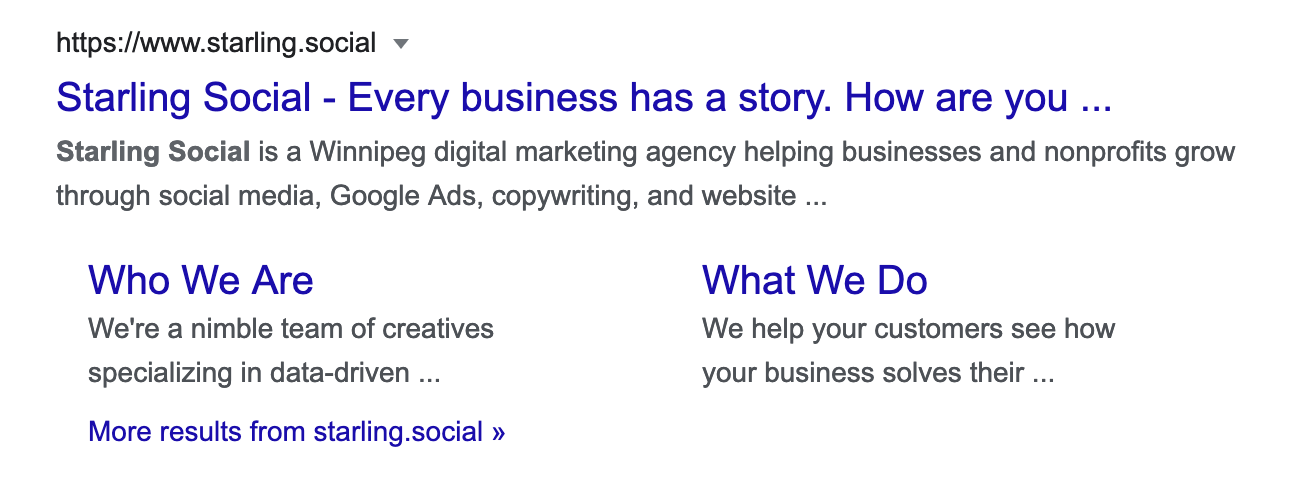
If you check out your website’s HTML, you can find it in the <head> section </head>. Updating it can be tricky if you aren’t a web developer, so we recommend using Yoast SEO for this purpose if you’re serious about optimizing for SEO.
How to write eye-catching meta descriptions
Meta descriptions need to do two things: rank well in a search, and be engaging enough to capture readers’ attention and encourage them to click.
Make sure to keep keyword intent in mind. Keyword intent is the reason behind the keywords.
Think about it this way: if you’re a digital marketing agency (like us, hello), then you might assume that you'd want to target only keywords like “digital marketing agency” — but if someone else is typing those words into Google, what are they looking for?
Obviously they want to find a digital marketing agency, but why? Maybe they want help understanding how to run Facebook ads, or how to grow their following on Instagram.
Whatever it is, your meta description needs to speak to those needs! Use this tip sheet as your guide:
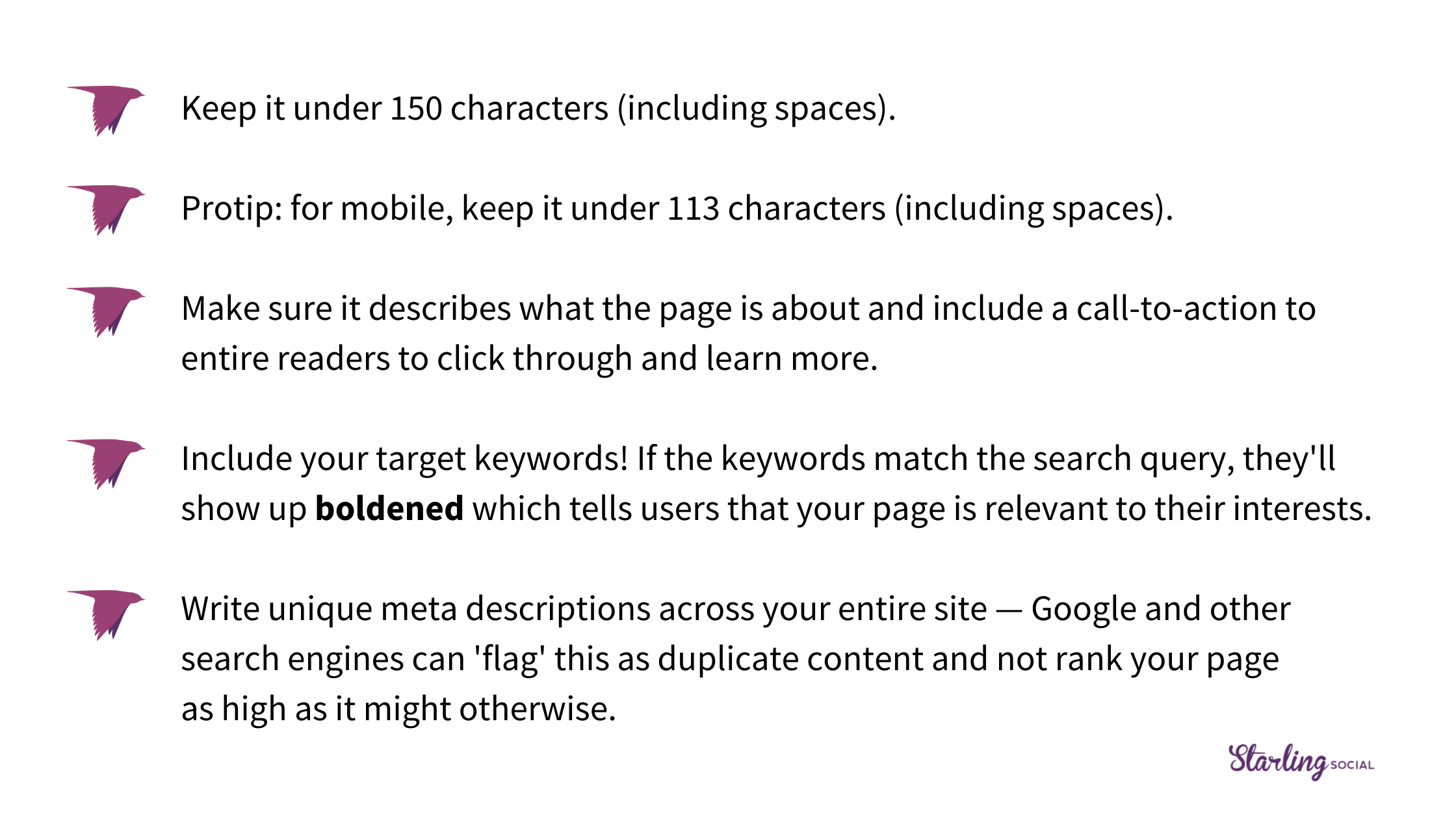
4. Keyword frequency and density
Keyword frequency refers to how often your keywords appear on your page.
Keyword density, on the other hand, refers to the ratio of your keyword phrase to other words on the page.
If you write a 1000-word post with the target keyword phrase “professional Manitoba photographer” — how many times does that phrase come up, and how much are you using it in relation to the other words on the page?
Overdoing it here is called “keyword stuffing”. Jamming your keyword (or phrase) into your text too many times can cause search engines to flag your page as “spammy”, and also has the unfortunate side effect of making your content look spammy, too.
Here’s an example of how not to do it:
“For the best professional Alberta photographer look no further. We offer the highest-quality professional Alberta photography at competitive rates. Want to learn about our professional Alberta photography services? Click here.”
Not great, right?
The example above is pretty obvious, but if you’re not sure what your keyword-to-content ratio is, we suggest using the SEObook keyword density tool.
5. Page links
Page Links are how search engines see that your website is connected to the rest of the web and that your content is useful enough that it links to other, relevant content online.
Google’s stated mission is to organize the world’s information and make it accessible, so adding outbound links to your content indicates that you value what other people have to say, which helps your website as more valuable to search engines.
What SEO copywriters (like us) do is identify target keywords, research supporting and accurate information to support our content, and then use both to create useful and interesting content.
There are no “hard and fast” rules about page linking, but here are a few to keep in mind:
- Link to relevant pages within your own site
- Link to in-depth 3rd party guides and resources
- Link to other pages with appropriate anchor text* that sounds natural
* WordStream defines anchor text as “the clickable text in a hyperlink”
Bonus: site speed
Site speed isn’t technically related to SEO copywriting, but how fast your website loads play a huge role in how your website ranks on a SERP so we’d be remiss if we didn’t mention it.
According to a study by Akamai, 53% of people will abandon a web page if it takes more than 3 seconds to load, and mobile sites that loaded in 5 seconds earned almost double the revenue of sites that took 19 seconds to load.
If your web page takes more than two seconds to load, you could be losing out on valuable traffic! We recommend testing your website’s loading speed using Google’s PageSpeed insights tool.
SEO copywriting tools
Looking for more tools to increase your SEO copywriting abilities? Check out this list of handy resources:
Hemingway App. This tool identifies excess text and helps keep your copy short and snappy (just like Hemingway’s writing).
Coschedule Headline Analyzer. Exactly what it sounds like.
Moz Keyword Explorer. A keyword research tool that gives you up to 10 free keyword searches a month with a free account.
Google’s 200 Ranking Factors: The Complete List: Exactly what it sounds like.
Start writing better SEO copy today
Following these SEO copywriting strategies will help you drive more traffic to your website, improve your brand’s reputation, and (most importantly) write content that people and search engines love.
And hey — if you thought this was a useful post and you want to get more of this kind of content (ours and others) delivered to your inbox once a week, subscribe to our newsletter.
How to Use The KonMari Method for SEO
- by Alyson Shane
One of this season's most binge-worthy Netflix shows is, undeniably, Tidying Up with Marie Kondo. This charming and quirky reality tv show follows Marie Kondo, a Japanese organizing consultant and creator of the KonMari method, as she visits families to help them organize and tidy their homes.
As you can see, Marie Kondo has quickly become a household name since then:
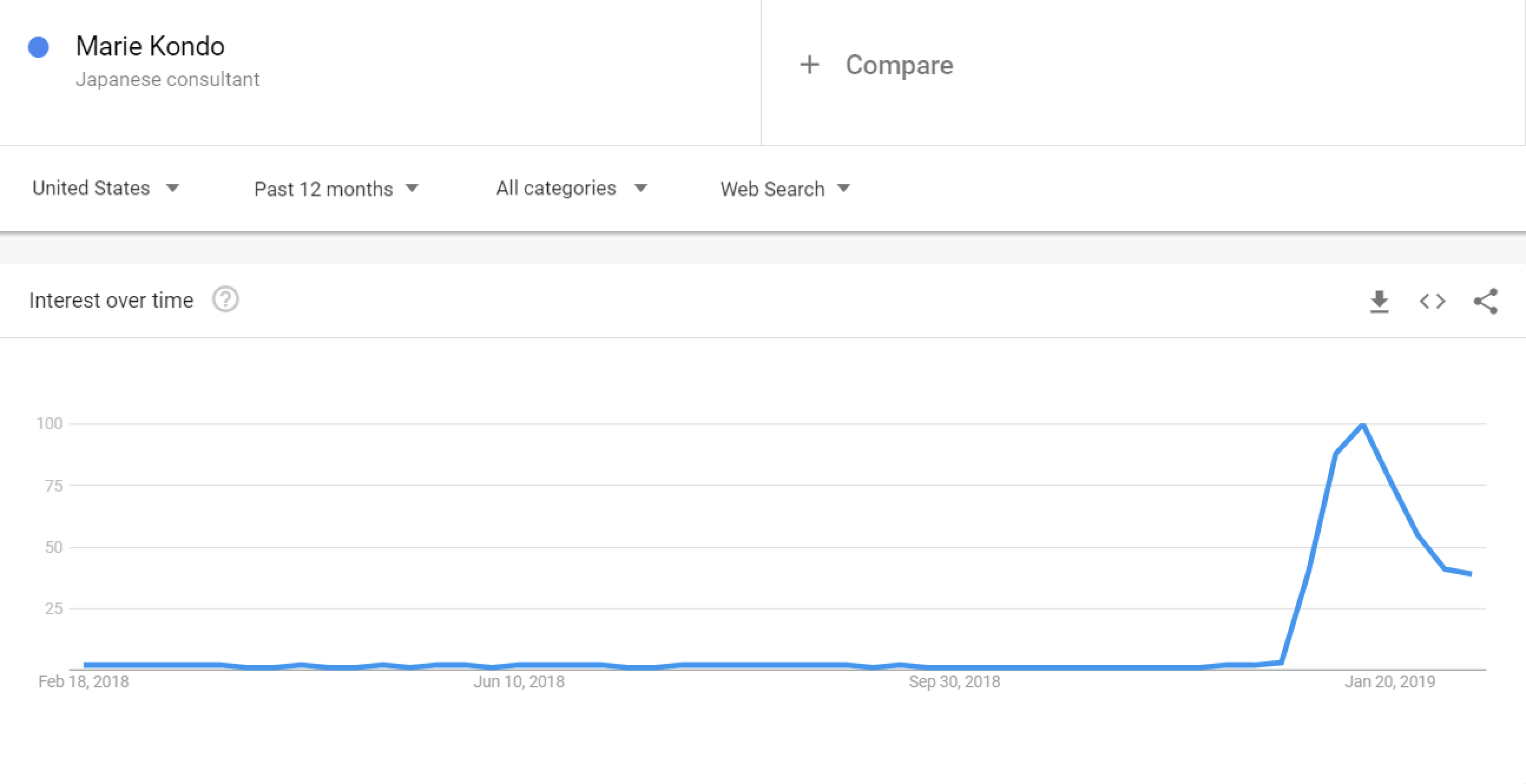
Since KonMari has been such a success at helping improving their personal lives, we started thinking: what if we applied the principles behind KonMari to improve SEO?
What can we "tidy up" to improve our organic page rank?
What about our pages (or website!) doesn't spark joy?
Today we're going to explore these themes (and more!) as commit ourselves to developing an SEO strategy that keeps our websites clean, tidy, and building towards our ideal lifestyle. Let's dive right in:
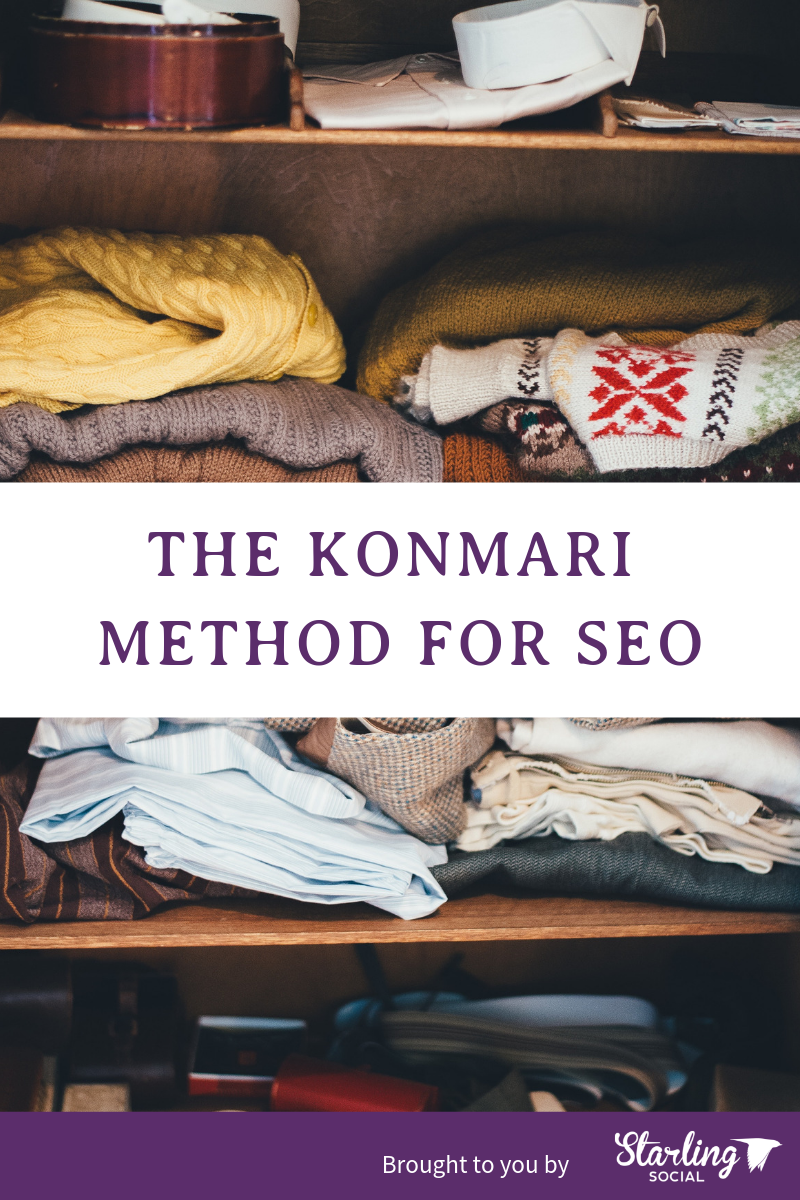
Applying KonMari to SEO
How can we apply the KonMari method to the basics of SEO? Let's start by considering The 6 Basic Rules of Tidying Up:
- Commit yourself to tidying up
- Imagine your ideal lifestyle
- Finish discarding first
- Tidy by category, not by location
- Follow the right order
- Ask yourself if it sparks joy
Okay - maybe at first glance SEO and KonMari don't seem 1-1, but stick with us: we've massaged these principles into a roadmap so you can declutter your website and create an SEO strategy that sparks joy.
1. Commit Yourself to Tidying Up (Your Website)
SEO success doesn't happen overnight. It takes time, effort, and an investment in areas like content creation (hello, blog posts!), a social media strategy, and an ongoing commitment to creating a website that is responsive, easy to read, and includes keywords and phrases that boost your organic Search Engine Page Rank (SERP).
Commit yourself to doing a proper SEO audit at least once per fiscal quarter, and to implementing any steps needed to correct the errors you find. Commit resources to tools that make sure you're receiving actionable data - and if you don't have the knowledge (or time) to do it yourself, partner with someone who can.
2. Imagine Your Ideal Lifestyle (Once Your Website Reaches Its Full Potential)
Ask yourself: what does success look like to me, and what kind of lifestyle would that mean for my life? Spend time thinking about the type of life you want to live, and how your website contributes to that success.
For example, figure out which keywords will help your website be seen by as much of your target audience as possible, and then rank those keywords based on which of them would drive your "ideal lifestyle" (aka: growing your business, closing leads, generating revenue, etc.)
3. Finish Discarding (Low-Quality Content) First
Before we can dive into the process of tidying up and sparking joy, we need to start by discarding the things that are no longer bringing us joy.
For your website, this can include:
Clear Up Search Indexes. Find any old PDFs, subdomains, or subfolders that may be hanging around and get rid of them.
Discarding Old Content. Reevaluate your website, tighten up your content blocks, and remove any stale or irrelevant content.
Discard Irrelevant Items. Review your robots.txt to make sure you're not blocking any items that search engine crawlers may need to access to index your site.
Disregard Irrelevant Pages. When was the last time you cleaned up your web pages? If you've never removed old or irrelevant pages, use sitemap tool to get started.
4. Tidy by Category, Not By Location (in the SERP)
Now that we've taken care of discarding the useless stuff, we can focus on tidying up our websites based on category, not where we want to end up on a SERP.
Some things you can tidy (aka optimize based on keyword research) include:
- Meta titles
- Meta descriptions
- Headers (H1, H2s, etc.)
- Image alt texts
- Meta descriptions
5. Follow the Right Order (As You Go Through Your SEO Efforts)
This is where things can get a bit tricky: not only do you need to use your understanding of what will make the biggest impact re: your ranking factor, but you also need to figure out how to implement those changes efficiently.
6. Ask Yourself If It "Sparks Joy" (Hint: a Boost to Organic SEO Should 'Spark Joy'!)
This should be obvious: are the steps you're taking leading you to the results you want? Are the changes you're implementing helping, or harming your SERP ranking?
If not, stop spending time on those tactics and start focusing on changes that contribute to your ideal lifestyle (see #2 in this list). For example, if you're spending a ton of time creating content that isn't yielding the results you're looking for (aka: sparking joy) then pause that and re-evaluate ways you could be spending your time that would lead to more joy.
Getting Organized, The SEO Way
Even if you don't follow the KonMari method word-for-word, it's important to have an organizational plan to help you stay on top of your SEO efforts. As this industry continues to grow and impact how businesses find their customers (and vice-versa) it's not enough to assume that we can fix SEO problems as they happen - we need to be active in identifying and resolving them.
How do you find joy in your content and SEO? Tweet us!
Have a question about SEO? Leave us a comment on our Facebook page.
Want help developing a strategy that earns you the SERP ranking you want? Drop us a line.
Want to follow our Company Page? Follow us on LinkedIn.
Want some nice stuff to look at every day? Let's connect on Instagram.
Looking to stay up-to-date with our posts? Subscribe to our newsletter.
Here Are the Answers to Your Hottest Local SEO Questions
- by Alyson Shane
Looking for answers to your hottest local SEO questions? We've got 'em!
SEO is a "hot button" topic these days, and as businesses look for ways to expand their organic (non-paid) reach in order to help potential customers find them, many are waking up to the fact that spending a little time optimizing their website and Google My Business pages will help their business rank higher on a Search Engine Results Page (SERP.)
With that in mind, today we're going to answer some of the most common questions we hear from our clients when it comes to optimizing for local SEO. Let's dive right in:
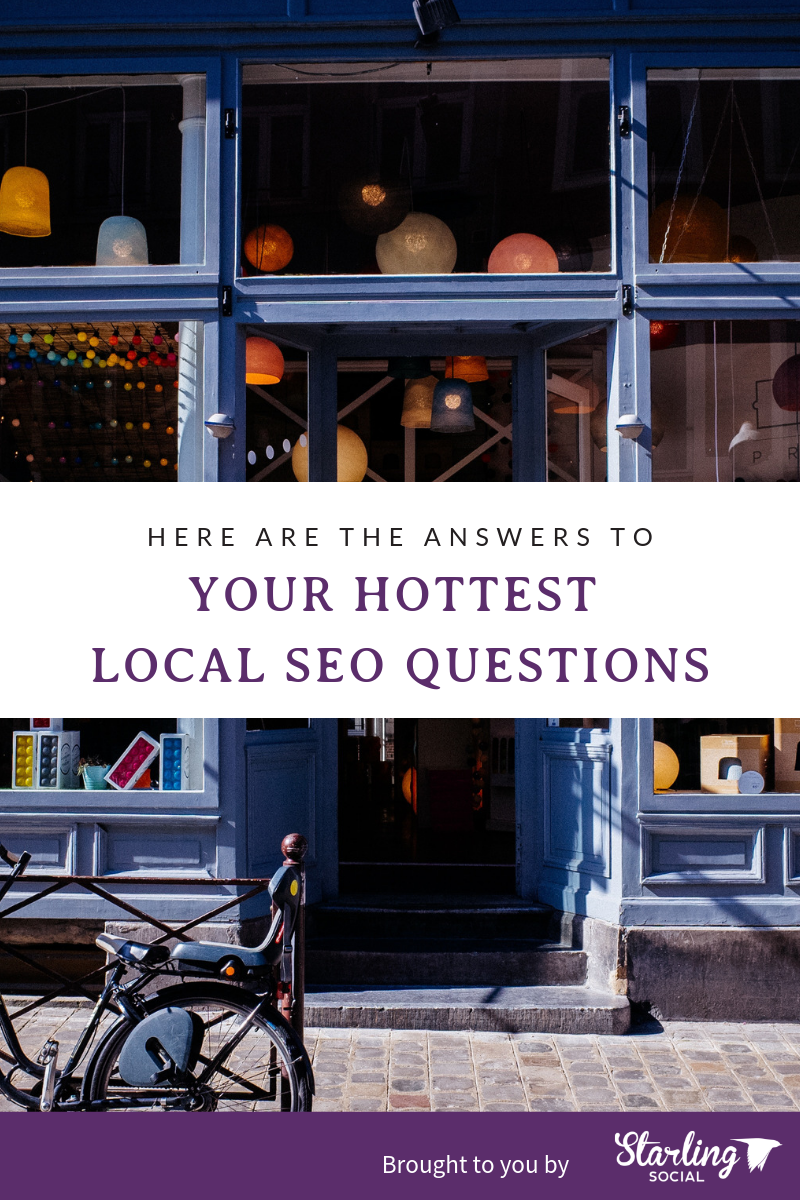
"How has local SEO changed recently?"
Google makes so many updates to their search algorithms and associated business services that it can feel confusing to keep track of it all, so here are some of the most important changes that have taken place over the past few years:
- Google has anchored Local Packs (the top three results you see after performing a search) to pretty much every SERP that it considers to be locally-focused. This is a big boon for businesses who have registered an account with Google My Business, Google Maps, etc.
- Google My Business has also rolled out several features to help differentiate your business from your competitors, including: Posts, Product Posts, Q&A, Messages, Video, and more. By completing and updating as many of these features as possible, you can really hone your content offerings to target local search.
- There have been a lot of rumblings recently about the explosion of voice and mobile search, but to date these trends haven't appeared to affect local SEO beyond ensuring that your data is clean and consistent across the web. This will be beneficial when the Internet of Things (IoT) becomes even more commonplace than it already is because it will allow businesses to easily integrate into these systems.
- Reviews and link building continues to be critical for local SEO success.
"How do I beat out competitors like Yelp when I have a small budget?"
The good news for small and medium businesses (SMBs) is that Google has an incentive to show more truly local businesses in each Local SERP, which means there's less opportunity for big companies like Yelp to dominate over the competition, even if you have a modest budget.
As long as you have your basic website, Google My Business Page, and your local citations set up and up-to-date, earning a high ranking on an SERP becomes a game of links, reviews, and content.
In particular, SMBs need to focus on gaining positive customer reviews on Google, Yelp, and any other site that's relevant to your target market or industry. Another way to attract new customers is to make use of the Posts feature in Google My Business, which is a great (free!) way to attract new customers who may already be familiar with your brand.
"How much does social media impact my local SEO efforts?"
Social media doesn't appear to play a huge role outside of reviews. Instead, focus your "social SEO" efforts into being active on social platforms where you know your customers spend their time. For example, if your business markets products at women who are 45+, then your business should have an active Facebook Business Page, at the very least.
"How do I differentiate myself from other local businesses in my industry?"
The best way to truly differentiate yourself from local competitors is to build a brand with a voice and tone that sounds unique online, and which helps potential customers see you as "different" than other, similar businesses.
This typically comes down to how well you convey your values, and how well you can explain how your product or services will solve your customers' problems.
Of course, many businesses who are just starting out and don't have a lot of word-of-mouth activity can still earn high local SEO rankings by setting up their website and GMB pages and focusing on getting links and reviews.
"What are the 'must-haves' for succeeding in local SEO?"
Businesses that kill it at the local SEO game all share the same qualities:
- Their a website is easy for Google to recognize, understand, and navigate.
- Their Google My Business pages are optimized them using Posts, Q&As, etc.
- All their local citations are in place in GMB.
- They have a content strategy to target high-converting search queries.
- They consistently generate customer reviews.
- They build and get links.
Remember: winning at local SEO isn't a one-time play; it takes ongoing effort to make sure that your website continues to rank highly in local SERP results!
Optimize Your Local SEO Today
Getting your business listed in Google's SERP Local Pack won't happen overnight, but by taking the proper steps to optimize your website, Google My Business profile, and focusing on getting a steady stream of reviews from places like Google, Yelp, and other niche-specific review sites, you can start to work your way into that exclusive club of anchored Local Packs.
Are you trying to rank for local results in your city? Drop us a line.
Have a comment or question on what we just covered? Leave us a comment on our Facebook page.
Have a hot local SEO tip to share? Tweet us your favorite.
Looking for a more B2B connection? Follow us on LinkedIn.
Want some eye candy? Let's connect on Instagram.
Want to stay in touch? Subscribe to our newsletter.
SEO Research Tips for Building Your B2B Content
- by Alyson Shane
The most compelling business websites are informational, engaging, and accessible, but it’s not enough to have great content; your website also needs to be optimized to rank well in search engines in order to help prospects and readers find your content.
With this in mind, building a content marketing strategy for your business which includes a strong Search Engine Optimization (SEO) plan is necessary in an area when content is widely available, and the market is more competitive than ever, with 81% of B2B Decision Makers reporting that they conduct research on a company’s products and services before scheduling a vendor meeting. This means that your your website copy needs to be consistent in voice and tone, as well as optimized for SEO.
For content creators in B2B organizations, nailing down the phrases that prospects are plugging into search engines can feel tough. Not only can it seem like an endless process, but some content developers may feel as though they don’t have the necessary tools or expertise to get the job done.
The good news? Content creators in B2B businesses don’t need top-notch tools or years of experience developing high-quality SEO content.
Crafting great content that is SEO-driven for potential leads doesn’t have to be a mind-numbing or frustrating process. Here are some helpful SEO research tips to save you time and convert prospects into active leads:
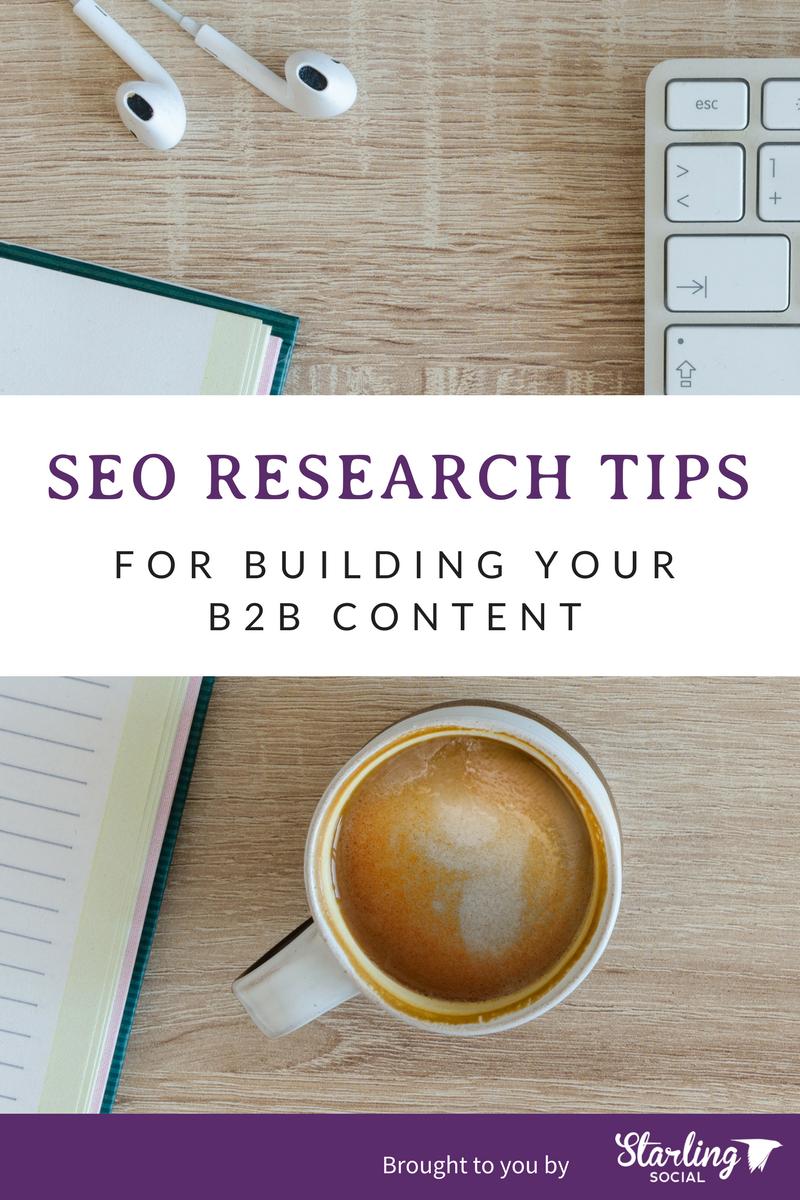
1. Copy Social Media for Keywords Straight From Your Clients
For both B2B and B2C companies, your social media platforms are a hotbed of useful information and prospect engagement. These channels are commonly used by businesses to share their experiences, thoughts, and opinions.
As a B2B company searching for keywords that your clientele relate to your business, you can use these communication platforms to your advantage by tapping into your network and creating leading questions that allow B2B prospects to share their thoughts on your brand and business.
Twitter polls, for example, allow your online community to weigh in quickly and easily on the topic you’re researching. This means that you can gauge which keywords your audience associates with your brand while allowing for further discussions you can use in other areas of your content marketing strategy.
2. Use Technology to Find Relevant Data
Tools such as Google Analytics and the associated Keyword Planner have been tools of choice for B2B businesses for years. Whether you’re a large organization or a smaller vendor or a product or service, these tools are essential for a successful foray into SEO keyword and content development.
Often used for providing cost-per-click information, average search volume data, and creating paid search campaigns, these tools provide you with measurable data so that you can see what SEO tactics are working, and which you can further refine.
This data helps B2B business’ research and discover opportunities for greater reach, relevant keywords, and move deeper into creating a unique content plan that stands out in your chosen industry.
3. Complete Relevant Keywords Searches in Incognito Mode
If you’re a marketer then you probably have an ever-expanding collection of keywords that relate to your company’s product or service.
When you enter these keywords into your chosen search engine to see where your content is on the results page, you may be surprised to find that you’re close to the top. However, this probably isn’t a coincidence: browsers can use your history or cache to impact the results to make them as relevant to your experience as possible.
In order to conquer this system, you can perform an incognito search. Input your priority or high-performing keywords and then check where your page shows up. Take a gander at the content that fills up the first 5 spots and take notes on their keyword use, spacing, and other SEO factors that may be pushing them up on the results page.
4. Writing SEO Content Based On Keywords
When it comes to actually creating the SEO content, best-in-class content is that which plays into what a prospect wants to read and the specific keywords you should be targeting. Keep your list of developed keywords closeby as you’re creating content and reference back to Google Trends every once in awhile to ensure that your topics and keywords are relevant.
Get ready to gain traffic, earn prospects, and close more B2B deals with content that is SEO-driven and ready to perform. Have you used any of these tools to up your SEO game lately? Tweet at us and let us know!
Want more insight and tools to help your brand stand out online? Download our free ebook Get Social! Content Marketing for You & Your Brand now.

